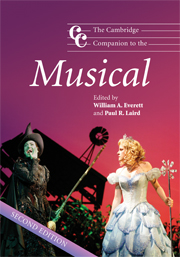Book contents
- Frontmatter
- Part I Adaptations and transformations: before 1940
- 1 American musical theatre before the twentieth century
- 2 Non-English-language musical theatre in the United States
- 3 Birth pangs, growing pains and sibling rivalry: musical theatre in New York, 1900–1920
- 4 American and British operetta in the 1920s: romance, nostalgia and adventure
- 5 Images of African Americans: African-American musical theatre, Show Boat and Porgy and Bess
- 6 The melody (and the words) linger on: American musical comedies of the 1920s and 1930s
- Part II Maturations and formulations: 1940–1970
- Part III Evolutions and integrations: after 1970
- Part IV Legacies and transformations
- Notes
- Select bibliography
- Index
1 - American musical theatre before the twentieth century
from Part I - Adaptations and transformations: before 1940
Published online by Cambridge University Press: 28 September 2011
- Frontmatter
- Part I Adaptations and transformations: before 1940
- 1 American musical theatre before the twentieth century
- 2 Non-English-language musical theatre in the United States
- 3 Birth pangs, growing pains and sibling rivalry: musical theatre in New York, 1900–1920
- 4 American and British operetta in the 1920s: romance, nostalgia and adventure
- 5 Images of African Americans: African-American musical theatre, Show Boat and Porgy and Bess
- 6 The melody (and the words) linger on: American musical comedies of the 1920s and 1930s
- Part II Maturations and formulations: 1940–1970
- Part III Evolutions and integrations: after 1970
- Part IV Legacies and transformations
- Notes
- Select bibliography
- Index
Summary
The history of musical comedy begins in confusion.
edith borroffMost histories of American musical theatre give short shrift – at best – to the ‘origin of the species’, to use Edith Borroff's apt phrase. Despite lofty ambitions (titles that claim coverage ‘from the beginning to the present’), most authors are content to offer a brief essay about the antecedents of musical comedy, usually including definitive identification of ‘the first American musical’ (The Black Crook, Little Johnny Jones, Evangeline, Show Boat, The Beggar's Opera, The Wizard of the Nile or any number of other works), before turning, with an almost discernible sigh of relief, to musical theatre of the twentieth century. The reasons for the brevity and for the disagreement on the ‘first’ musical become readily apparent as soon as one attempts to sort out the myriad different types of musical theatrical forms that materialised, metamorphosed, became popular, disappeared, re-emerged and cross-fertilised prior to the twentieth century. To put it simply, for the scholar in search of a clear lineage to the forms of the twentieth century, musical theatre in the eighteenth – and even more so in the nineteenth – century was a tangled, chaotic mess. This was not the impression at the time, of course. To the contrary, a nineteenth-century American, especially the resident of a large city like New York, found musical theatrical life during the time to be gloriously rich, varied and ever-changing; it was a world that was entertaining, interesting, exciting and innovative to an extent that should elicit a twinge of envy from the modern reader. But the job of the historian is to clarify and attempt to put into some kind of order the messiness of a bygone era. And the richness of that period makes the job both difficult and important.
- Type
- Chapter
- Information
- The Cambridge Companion to the Musical , pp. 1 - 28Publisher: Cambridge University PressPrint publication year: 2008
- 2
- Cited by



